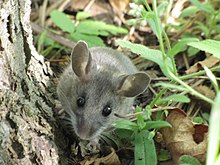
The harvest mouse is a small rodent native to Europe and Asia. It is typically found in fields of cereal crops, such as wheat and oats, in reed beds and in other tall ground vegetation, such as long grass and hedgerows. It has reddish-brown fur with white underparts and a naked, highly prehensile tail, which it uses for climbing. It is the smallest European rodent; an adult may weigh as little as 4 grams (0.14 oz). It eats chiefly seeds and insects, but also nectar and fruit. Breeding nests are spherical constructions carefully woven from grass and attached to stems well above the ground.
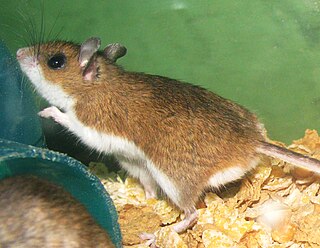
Peromyscus is a genus of rodents. They are commonly referred to as deer mice, not to be confused with the chevrotain or "mouse deer." They are New World mice only distantly related to the common house and laboratory mouse, Mus musculus. From this relative, Peromyscus species are distinguished by relatively larger eyes, and also often two-tone coloring, with darker colors over the dorsum (back), and white abdominal and limb hair-coloring. In reference to the coloring, the word Peromyscus comes from Greek words meaning "booted mouse". They are also accomplished jumpers and runners by comparison to house mice, and their common name of "deer mouse" is in reference to this agility.

The meadow vole, sometimes called the field mouse or meadow mouse, is a North American vole found across Canada, Alaska and the northern United States. Its range extends farther south along the Atlantic coast. One subspecies, the Florida salt marsh vole, is found in Florida, and is classified as endangered. Previously it was also found in Chihuahua, Mexico, but has not been recorded since 1998.
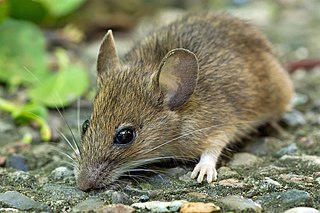
The wood mouse is a murid rodent native to Europe and northwestern Africa. It is closely related to the yellow-necked mouse but differs in that it has no band of yellow fur around the neck, has slightly smaller ears, and is usually slightly smaller overall: around 90 mm (3.54 in) in length and 23 g in weight. It is found across most of Europe and is a very common and widespread species, is commensal with people and is sometimes considered a pest. Other common names are long-tailed field mouse, field mouse, common field mouse, and European wood mouse.

The white-footed mouse is a rodent native to North America from Ontario, Quebec, Labrador, and the Maritime Provinces to the southwestern United States and Mexico. In the Maritimes, its only location is a disjunct population in southern Nova Scotia. It is also known as the woodmouse, particularly in Texas.
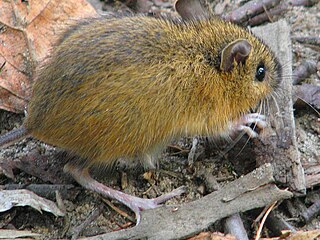
The woodland jumping mouse is a species of jumping mouse found in North America. It can jump up to 3 m (9.8 ft) using its extremely strong feet and long tail.
The Texas mouse is a species of rodent in the family Cricetidae. It is found in Arkansas, Kansas, Missouri, Oklahoma, and Texas in the United States.
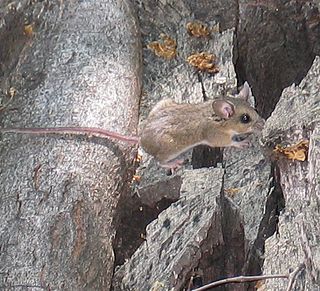
The brush mouse is a species of rodent in the family Cricetidae. It is found in mountainous areas of Mexico and the western United States at altitudes over 2,000 m (6,600 ft).

The California mouse is a species of rodent in the subfamily Neotominae in the family Cricetidae. It is the only species in the Peromyscus californicus species group. It is found in northwestern Mexico and central to southern California. It is the largest Peromyscus species in the United States.

The Zacatecan deer mouse or southern rock mouse is a species of rodent in the family Cricetidae. It is found only in Mexico, and is not considered endangered.

The cactus mouse is a species of rodent in the family Cricetidae. It is one species of a closely related group of common mice often called deer mice. Cactus mice are small, between 18 and 40 g in weight. Females weigh slightly more than males and are significantly larger in body length, ear length, length of mandible, and bullar width of skull. Cactus mice can be identified by having naked soles on their hind feet and almost naked tails, which are usually the same length or longer than the animals' body length. Their ears are nearly hairless, large, and membranous. Their fur is long and soft; coloration varies between subspecies and between different populations. Color of fur varies from ochre to cinnamon, with white ventral areas, and the sides and top of head slightly grayish. Females tend to be slightly paler in color than males, while juveniles appear more gray than their parents.

The cotton mouse is a species of rodent in the family Cricetidae found in the woodlands of the Southeastern United States.
Hooper's mouse is a species of rodent in the family Cricetidae. It is the only member of the Peromyscus hooperi species group, and is found only in Mexico. The species is named for Emmett Hooper, a researcher into the taxonomy of the genus Peromyscus.

The black-eared mouse, or black-eared deer mouse, is a species of rodent in the family Cricetidae, native to North America.
The Mexican deer mouse is a species of forest-dwelling rodent in the family Cricetidae. It is found in southern Mexico and throughout much of Central America.
The tawny deer mouse or marsh mouse is a species of rodent in the family Cricetidae. It is found only in Mexico.

The Great Basin pocket mouse is a species of rodent in the family Heteromyidae. It is found in British Columbia in Canada and the western United States.

The western jumping mouse, is a species of rodent in the family Dipodidae. It is found in Canada and the United States.
The giant island deer mouse became extinct approximately 8000 years BP and lived during the late Pleistocene on California’s Channel Islands.

Cuterebra fontinella, the mouse bot fly, is a species of New World skin bot fly in the family Oestridae. C. fontinella is typically around 1 mm (0.039 in) in length with a black and yellow color pattern. C. fontinella develops by parasitizing nutrients from its host, typically the white-footed mouse. C. fontinella has even been known to parasitize humans in rare cases. Individuals parasitized by C. fontinella will develop a large bump on the skin that is indicative of parasitization.
